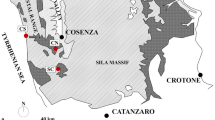Abstract
Certain kinds of stone used in buildings of archaeological, historic and architectural significance resemble aggregate of micrometre size, of weakly cemented, essentially calcite particles, containing numerous voids. Below the results are presented of an experimental investigation conducted for the purpose of determining the water-induced weakening effects on such stone. A calcarenite of the Sardinian Miocene (Cagliari pietra cantone) has been selected as model material for the investigation. Its microstructure is characterized by means of XRD, ESEM and MIP techniques. Compression strength, ultrasound propagation velocity and elongation provide an indication of the role played by various fluids (water, aqueous sodium chloride solution, kerosene) in weakening the interparticle bonding forces of the calcite grains. Permeability, pH and calcium ions concentration in the permeating water, on the other hand, point to the dissolution behaviour and hence weakening effects of water permeating through this type of microstructure.
Similar content being viewed by others
References
Galan E (1989) Carbonate rocks-Alteration and control of stone quality: some considerations. In: The Conservation of Monuments in the Mediterranean Basin, Proceedings of the 1th International Symposium, Bari (Zezza F. ed., Grafo Edizioni, Brescia, 1990) 249–254.
Vannucci S, Alessandrini G, Cassar J, Tampone G, Vannucci ML (1994) Prehistoric megalithic temples of the maltese arcipelago: causes and mode of deterioration of globigerina limestone. In: The Conservation of Monuments in the Mediterranean Basin, Proceedings of the 3rd International Symposium, Venezia, (Fassina V, Ott H, Zezza F, eds., Soprintendenza ai Beni Artistici e Storici di Venezia, Venezia, 1994) 555–565.
Cassar J, Tampone G, Vannucci S (1989) Conservation of Prehistoric megalithic temples. In: The Conservation of Monuments in the Mediterranean Basin. Proceedings of the 1th International Symposium, Bari (Zezza F, ed., Grafo Edizioni, Brescia, 1990) 139–146, only available in Italian.
Rodolico F, Stones of the Italian Cities. (Le Monnier, Firenze). Only available in Italian.
Zezza U, Veniale F, Zezza F, Moggi G (1989) Effects of water saturation on the pietra leccese mechanical weakening. In The Conservation of Monuments in the Mediterranean Basin. Proceedings of the 1th International Symposium, Bari (Zezza F, ed., Grafo Edizioni, Brescia, 1990) 263–269. Only available in Italian.
Alessandrini G, Bocci A, Bugini R, Emmi D, Peruzzi R, Realini M (1992) Stone materials of Noto (Siracusa) and their decay. In: Deterioration and Conservation of Stone. Proceedings of the 7th International Congress, Lisbon, (LNEC, Lisbon, 1992) 11–20.
Pecorini G, Pomesano-Cherchi A (1969) Geological and biostratigraphic researches on Southern Campidano (Sardegna). Memorie della Società Geologica Italiana 8: 421–451. Only available in Italian.
Price CA Stone Conservation (1996) An Overview of Current Research. The Getty Conservation Institute, Santa Monica.
Meier PC, Zund RE (2000) Statistical Methods in Analytical Chemistry. J. Wiley & Sons, New York.
Brown G (1961) X-Ray Identification and Crystal Structures of Clay Minerals. Mineralogical Society, London.
Chamley H (1987) Sédimentologie. Bordas, Paris.
Folk RL (1982) Petrology of Sedimentary Rocks. Hemphills, Austin.
Colback PSB, Wiid BL (1965) The influence of moisture content on the compressive strength of rocks. In: Canadian Rock Mechanics. Proceedings of the 3rd Symposium, Toronto (University of Toronto, Toronto, 1965), 65–83.
Simpson DR, Fergus JH (1968) The effect of water on the compressive strength of diabase. Journal of Geophysical Research 73(20):6591–6594.
Guerrero MA, Vazquez MA, Galan E, Zezza F (1989) The physical-mechanical properties and ultrasonic data as criteria for evaluation of calcareous stone decay. In: The Conservation of Monuments in the Mediterranean Basin. Proceedings of the 1th International Symposium, Bari (Zezza, F. editor, Grafo Edizioni, Brescia, 1990) 309–312.
Weast RC ed. (1970) CRC Hanbook of Chemistry and Physic. The Chemical Rubber Co., Cleveland, E63, E67, F28–31.
Kozeny J (1927) On water capillary adsorption in solids. Sitzungsber. Akad. Wiss. Wien 136:271–306. Only available inGerman.
Carman PC (1937) Fluid flow through a granular bed. Transactions of the Institution of Chemical Engineers, 15:150–167.
Francis A, Dullien L (1975) New network permeability model of porous media. AIChE Journal 21:299–307.
Morse JW (1983) The kinetics of calcium carbonate dissolution and precipitation. In Reviews in Mineralogy. Carbonates: Mineralogy and Chemistry. Mineralogical Society of America, Washington, :227–264.
Fassina V (1988) Environmental pollution in relation to stone decay. Durability of Building Materials 5:317–358.
Atzeni C, Massidda L, Sanna U (1991) Models of dissolution of carbonate materials by acid waters. Materials Engineering 2(1):115–126.
Hoefner ML, Fogler HS (1988) Pore evolution and channel formation during flow and reaction in porous media. AIChE Journal 34(1):45–54.
Author information
Authors and Affiliations
Rights and permissions
About this article
Cite this article
Atzeni, C., Sanna, U. & Spanu, N. Some mechanisms of microstructure weakening in high-porous calcareous stones. Mater Struct 39, 525–531 (2006). https://doi.org/10.1007/s11527-005-9044-1
Received:
Accepted:
Published:
Issue Date:
DOI: https://doi.org/10.1007/s11527-005-9044-1




